Innovative strategy of ZIF-90 for co-immobilization of whole cells and enzymes in biocatalytic D-phenyllactic acid synthesis
IF 7.7
1区 化学
Q1 BIOCHEMISTRY & MOLECULAR BIOLOGY
International Journal of Biological Macromolecules
Pub Date : 2024-11-16
DOI:10.1016/j.ijbiomac.2024.137735
引用次数: 0
Abstract
In this study, we endeavored to catalyze the biosynthesis of D-phenyllactic (D-PLA) from L-Phenylalanine (L-Phe) through a one-pot method. However, the crucial enzymes for the biosynthesis of phenylpyruvate (PPA), amino acid oxidase (L-AAD), is a membrane-bound protein. Herein, we proposed a novel co-immobilization strategy of whole cells and enzymes, integrating them into ZIF-90 to achieve efficient biosynthesis of D-PLA. Consequently, we embarked on integrating both enzyme and E. coli into ZIF-90, ultimately obtaining the novel biocatalyst E. coli/LDH@ZIF-90. This achievement facilitated the cascade reaction between LDH and E. coli, enabling a streamlined one-pot bioconversion process. The morphology and structure of E. coli/LDH@ZIF-90 were thoroughly characterized using a range of methods, including XRD, SEM, FT-IR, CLSM, and XPS, which confirmed that the material had been successfully synthesized. Further activity experiments revealed that E. coli/LDH@ZIF-90 exhibited good stability even under harsh conditions. Additionally, the biocatalyst retained 76 % of its initial catalytic activity after completing six cycles. Moreover, when utilized for the biosynthesis of D-PLA, this system demonstrated an impressive conversion rate of 85.2 % after 12 h. The successful cascade catalysis from L-Phe to D-PLA underscored the potential of the enzyme-cell cascade catalytic system, offering valuable insights for its potential industrial applications.
在生物催化 D-苯乳酸合成中共同固定全细胞和酶的 ZIF-90 创新战略。
在这项研究中,我们致力于通过一锅法催化 L-苯丙氨酸(L-Phe)生物合成 D-苯基乳酸(D-PLA)。然而,苯丙酮酸(PPA)生物合成的关键酶--氨基酸氧化酶(L-AAD)是一种膜结合蛋白。在此,我们提出了一种新型的全细胞和酶共同固定策略,将它们整合到 ZIF-90 中,以实现 D-PLA 的高效生物合成。因此,我们着手将酶和大肠杆菌整合到 ZIF-90 中,最终获得了新型生物催化剂大肠杆菌/LDH@ZIF-90。这一成果促进了 LDH 与大肠杆菌之间的级联反应,实现了简化的一锅生物转化过程。利用 XRD、SEM、FT-IR、CLSM 和 XPS 等一系列方法对大肠杆菌/LDH@ZIF-90 的形态和结构进行了全面表征,证实该材料已成功合成。进一步的活性实验表明,即使在苛刻的条件下,大肠杆菌/LDH@ZIF-90 也表现出良好的稳定性。此外,生物催化剂在完成六个循环后,其初始催化活性保持了 76%。此外,当利用该系统进行 D-PLA 的生物合成时,12 小时后的转化率高达 85.2%,令人印象深刻。从 L-Phe 到 D-PLA 的成功级联催化突出了酶-细胞级联催化系统的潜力,为其潜在的工业应用提供了宝贵的启示。
本文章由计算机程序翻译,如有差异,请以英文原文为准。
求助全文
约1分钟内获得全文
求助全文
来源期刊
CiteScore
13.70
自引率
9.80%
发文量
2728
审稿时长
64 days
期刊介绍:
The International Journal of Biological Macromolecules is a well-established international journal dedicated to research on the chemical and biological aspects of natural macromolecules. Focusing on proteins, macromolecular carbohydrates, glycoproteins, proteoglycans, lignins, biological poly-acids, and nucleic acids, the journal presents the latest findings in molecular structure, properties, biological activities, interactions, modifications, and functional properties. Papers must offer new and novel insights, encompassing related model systems, structural conformational studies, theoretical developments, and analytical techniques. Each paper is required to primarily focus on at least one named biological macromolecule, reflected in the title, abstract, and text.

 求助内容:
求助内容: 应助结果提醒方式:
应助结果提醒方式:


